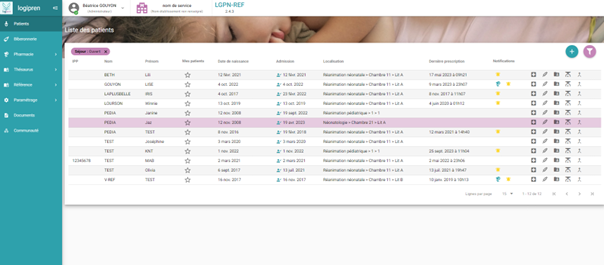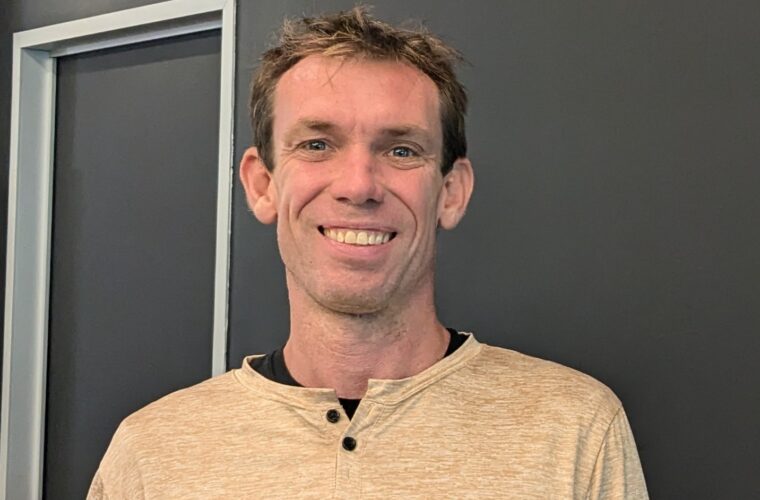From compassion to innovation: Dr. Gouyon’s neonatal care revolution
Dr Béatrice Gouyon, a mother of five and a dedicated paediatrician, stands at the forefront of a remarkable narrative in neonatal care. Her journey, marked by an unexpected shift, led to the creation of Logipren—a groundbreaking software designed by neonatologists for neonatology and pediatric intensive care units.
Logipren has revolutionized prescription management, eliminating arduous manual calculations for medical professionals and ensuring a greater focus on patient care. Beyond its practical applications, Logipren fosters collaboration among healthcare experts worldwide, promising to integrate AI advancements in the near future.
The impact of Dr. Gouyon and her dedicated team is impressive. Their relentless efforts have touched the lives of 176,303 infants across 82 institutions spanning the European continent. Their story is about compassion, innovation, and the unwavering pursuit of excellence. It is a testament to what can be achieved when determination and ingenuity converge to improve the lives of the most vulnerable among us. In this exclusive interview, we delve deeper into Dr. Gouyon’s journey, the evolution of Logipren, and its transformative impact on neonatal care across Europe.
What inspired you to create Logipren?
I joined the University Hospital of Réunion Island in 2011, where I continued the research I had previously conducted in Dijon, France, focused on improving healthcare quality. We identified a critical issue: medication errors in neonatal intensive care units. The challenge was to qualify the problem, investigate its causes, and identify the necessary rectification tools. In this context, my husband and I developed software to ensure the safety of prescriptions as part of a research program at the hospital. In Réunion, we had access to European research funds. Once the research phase was completed, we needed to establish a viable business model for what we had created. That’s why I left the hospital to have a private company take over the project, as the goal wasn’t to rely on perpetual subsidies.
Do you ever miss the hands-on practice of medicine today?
Yes, I have to admit I do miss it a bit, especially when I visit hospitals. I have a deep desire to get involved in patient care, but it’s just not possible. Starting a company is not something you can do on a part-time basis. It’s all-consuming.
How did you manage the transition from medicine, paediatrics, and intensive care to creating a startup?
For me, this transition was very enjoyable because I’m someone who absolutely loves to learn. So, when there are new things to discover and projects to launch, it aligns perfectly with my personality. It’s a continuous cycle of novelty and progress.
It was undoubtedly challenging when I made the switch. I completely left my comfort zone. I had to learn everything from scratch. When I wanted to make my first hire, the accounting firm asked about our collective agreement. I didn’t even know what that meant. As a hospital physician, there is no such thing as a collective agreement. You don’t handle HR, procurement, accounting, or anything else. You focus solely on patient care. So, I had to learn numerous aspects across various domains, which was fascinating. It continues to be a fascinating journey.
What was the turning point that motivated you to initiate your research?
The turning point came when we identified the problem of medication errors, where one in every six prescriptions in neonatal intensive care units was erroneous. This is a significant issue that is well-known to all physicians working in these units. Neonatal medicine is profoundly different from adult medicine, particularly in terms of medication prescription and preparation. We all remember instances where doses were given ten times higher than prescribed, leading to severe problems and, tragically, patient deaths. It’s a critical issue, and given my commitment to healthcare quality and my research interests, it became evident that something needed to be done.
What has been the most rewarding aspect of creating Logipren?
There are two aspects to this. Initially, I found great satisfaction in creating the software. However, as time passed, the ability to create jobs really stood out for me. When you can generate enough value to employ people month after month, that’s a genuine source of satisfaction. It’s the realization that you’ve built something of value with your own hands, enabling you to pay people’s salaries. This is something I hadn’t anticipated would bring me such joy. Today, Logipren employs 46 individuals.
Today, Logipren employs 46 individuals.
The second rewarding aspect is that I remain in close contact with my former colleagues, many of whom are department heads or physicians working in various healthcare services throughout France. I meet them at medical conferences, which I continue to attend, and they express their gratitude, saying, “We dreamed of this, and you made it happen. We can’t imagine practicing without this software. Thank you. It has eliminated medication errors.” Their feedback confirms that in real-world clinical practice, Logipren is indeed an invaluable and effective tool for preventing medication errors.
How did you handle the stress of starting a business? What Challenges did you face?
I’ve never been one to easily succumb to stress. I believe that in the field of neonatal intensive care, maintaining composure is not merely a preference but a necessity. It’s practically impossible to fulfill the demands of this profession while being easily stressed. For instance, when faced with a cardiac arrest, one must remain remarkably calm; otherwise, the situation can deteriorate rapidly. I have developed a strong ability to manage stress, yet dealing with the stress associated with building and managing a startup, especially over the long haul, is quite distinct from the stresses of neonatal care.
In the realm of startups, stress is a different beast. The journey is marked by waves of intense satisfaction, followed by plunges into significant challenges and formidable problems. However, these downswings are invariably followed by upswings. Over time, I’ve come to realize that these fluctuations are part and parcel of the entrepreneurial journey – a series of highs and lows. When confronted with a profound issue and it feels like you’ve hit rock bottom, I know from experience that within a matter of days, it will be resolved and replaced by a profound sense of accomplishment.
One of the everyday challenges faced by startups is managing internal conflicts among partners. For the first time, you’re navigating legal intricacies, grappling with labor disputes, and encountering difficulties with partners. These are areas that were largely unfamiliar to me, and each new challenge can initially feel overwhelming. Yet, with time and experience, it becomes easier to address them.
What obstacles did you have to overcome?
In the initial stages, when we were developing the software, we were still affiliated with the hospital. At that time, I had no intentions of founding a company or transitioning to the private sector. So, my husband and I drafted the software requirements. Subsequently, we approached major software corporations like Philips, General Electric, and Lucent, explaining the urgent need to develop this software to save children’s lives. However, they all responded that the task was overly complex, excessively costly, and fundamentally unprofitable due to the niche nature of the market – thus, they were unwilling to pursue it.

Is that when you decided to take matters into your own hands?
Indeed, after successfully developing the software, we encountered resistance from hospital IT departments. Initially, Logipren was provided free of charge as part of a research initiative, and we convinced some hospitals to adopt it. Later, they started paying for the service. Today, they require software to integrate ours, and nearly all French hospitals have implemented Logipren.
Do you have plans to expand internationally?
In France, we’ve made significant inroads, with a presence in almost 75-80% of hospitals. This percentage continues to fluctuate as we secure new contracts. We’ve virtually covered the entire landscape. Recently, we extended our services to encompass general paediatrics units, marking the initial stages of this expansion with 82 units, including two in Spain. Our future plans include venturing into the German market.

In terms of cost, what does a Logipren subscription represent?
With Logipren, you effectively minimize medication errors, encompassing both prescription and preparation, providing significant time savings for doctors. We’ve quantified this as the equivalent of having a full-time physician at your disposal for an entire year. Our subscription cost is roughly a third of the total, with the specific amount contingent on the size of the hospital unit.
There’s a crucial question regarding data protection. How do you secure your data?
It’s important to note that the data from our research software is anonymized. It’s stored with a certified health data host, which offers high security. These hosts are specialized, holding particular accreditations, making them highly resistant to potential breaches.
Who are your mentors?
I’ve been coached from the outset by a mentor who is not a public figure but is my brother. He’s an engineer in computer science and has founded several startups. He had gone through these experiences before I did. From the beginning, he guided me, telling me how things would unfold and what challenges I would face, including managing people. When we secured funding, even when we were approached for acquisition, he was there to guide us every step. Recently, he joined the company as the CEO after I finally managed to recruit him.
Have you received any acquisition offers?
Yes, there have been several offers. However, we’ve turned them down so far. It’s still too early. What’s interesting is that as soon as we launched our initial pilot programs, an editor who had previously declined to develop the software came back to us with a purchase proposal. I told them, “Wait, three years ago, we offered to have you do it yourselves, and we would assist you in the development. Why are you approaching us now?” We declined. Then there were two or three others. My goal is to ensure that it is genuinely useful, widely adopted, and not acquired prematurely, as often happens. From what I understand, if a very large organization acquired us and we were still a small product within their portfolio, there could be strategic decisions that might compromise our mission.
How do you envision the future of healthcare?
I believe healthcare will be significantly transformed with the advent of artificial intelligence. It will greatly enhance many aspects of healthcare. AI won’t replace doctors, and I’m not on that path at all, nor will it replace nurses, for that matter. However, it will considerably improve various facets of healthcare. We’re already seeing this in the field, with AI aiding in radiology readings, identifying skin lesions in dermatology, cancer screening, and interpreting medical scans. AI makes these processes faster and more accurate. So, we will gain in reliability and sensitivity. Our ability to diagnose conditions will improve. For example, the tool we’re working on, if it gains traction, I believe it will become a valuable resource. In essence, we’ll have very efficient tools, but we’ll always need the expertise of doctors and nurses.



